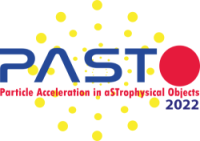Speakers
Description
A plasma outflow coming from the center of “Milk Way” Galaxy is simulated by an ion “beam” reaching a nearly stationary magnetic field “arch” with dimensions of the same order of magnitude as that of the Galaxy [1]. Then waves can be excited efficiently in the rarefied plasma (10-2-10-4 cm-3) permeating the relevant magnetic field configuration. These are electrostatic “Lower Hybrid” modes driven to instability via Cerenkov interaction [2]. By using a fluid model the relevant dispersion relation is derived and the growth rate is evaluated both analytically and numerically. Then efficient energy transfer from the perpendicular ion “beam” to the electron population, via Landau damping, can be expected accelerating fast electrons, or heating the overall electron population. The radiation emission due to the energetic electron component could explain the observed X and gamma-ray spectra characterizing the “Fermi Bubbles” of the Galaxy.
[1] H.-Y. K. Yang, M. Ruszkowski, E.G. Zweibel, Galaxies 6, 29 (2018).
[2] T. Chang and B. Coppi, Geophys. Res. Lett. 8, 1253 (1981).
*Sponsored in part by the U.S. Department of Energy and by C.N.R of Italy.

